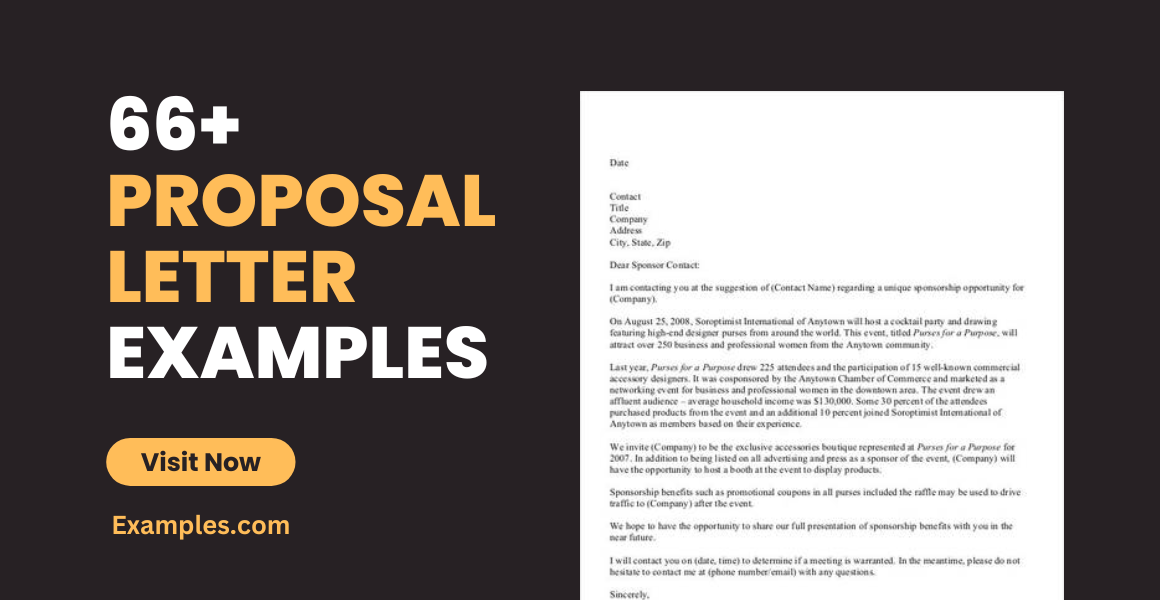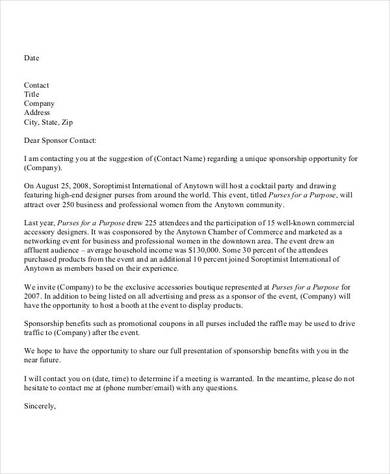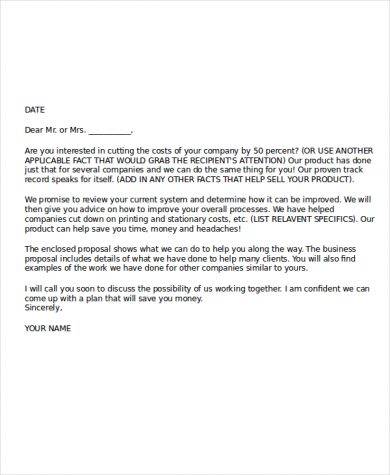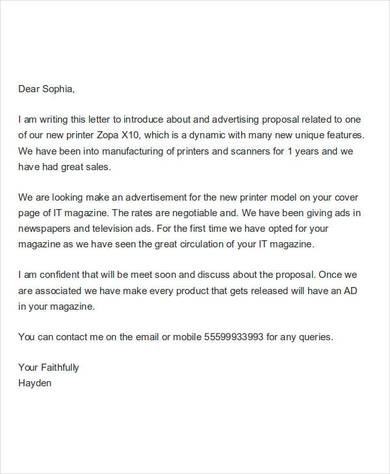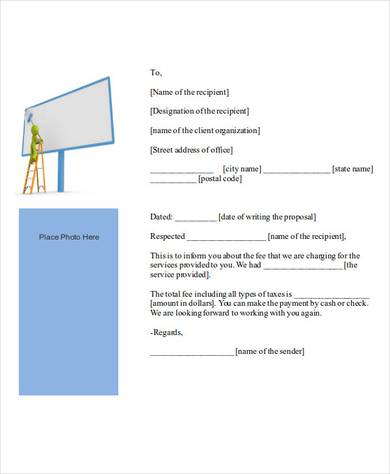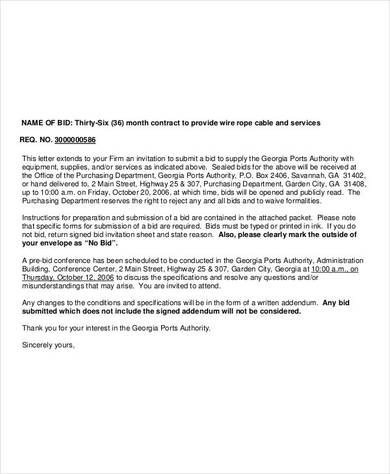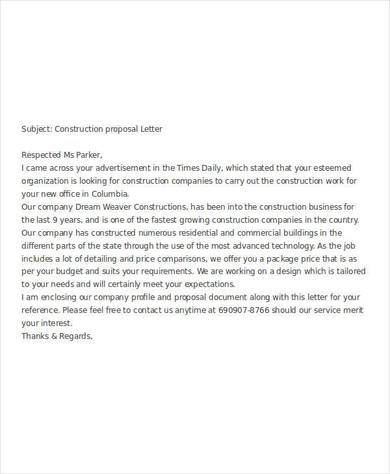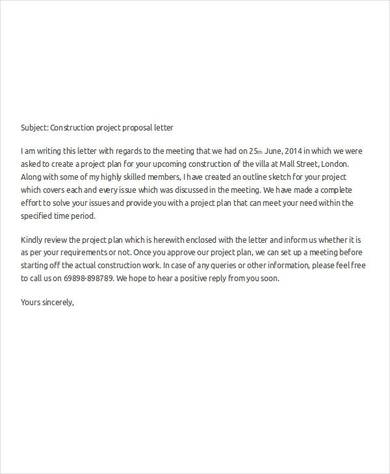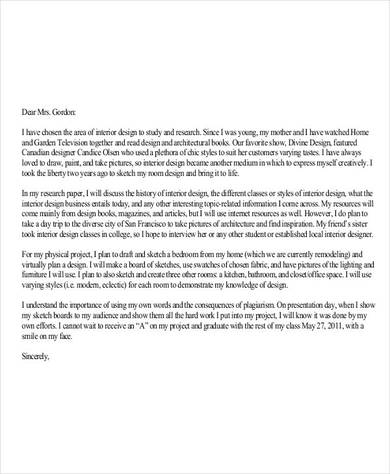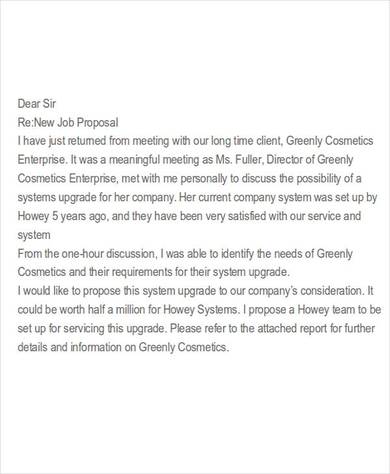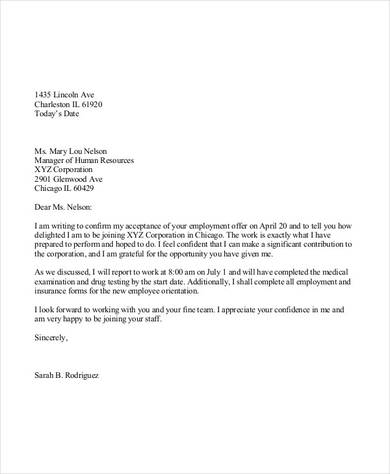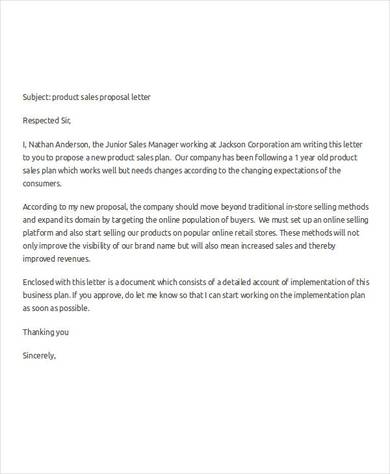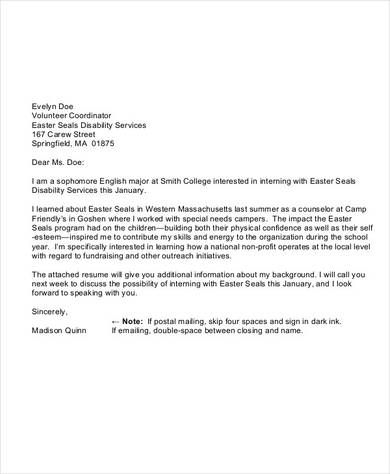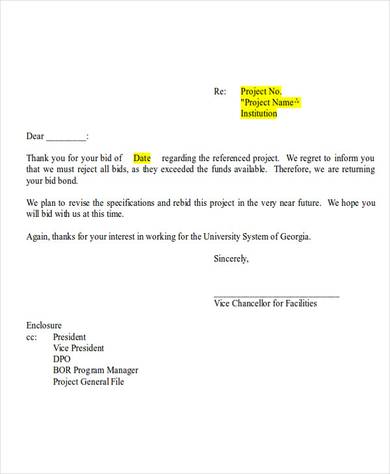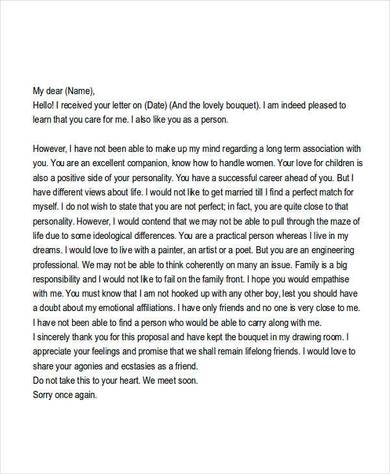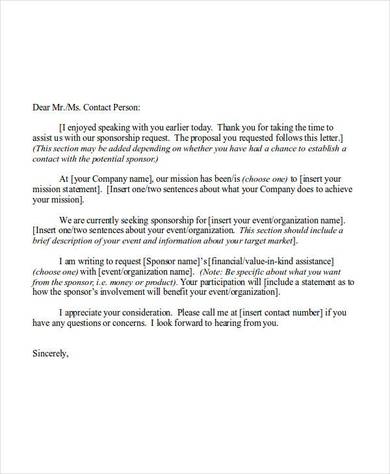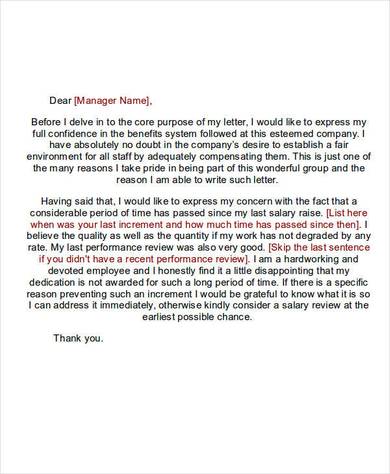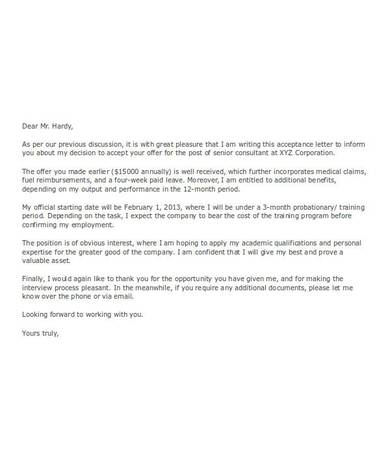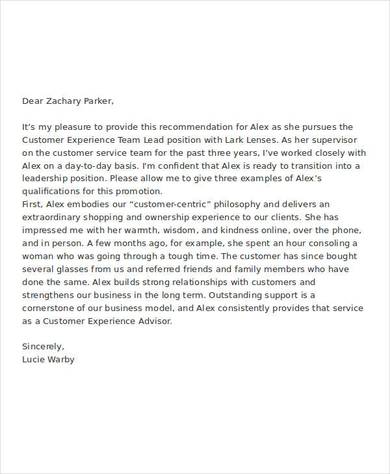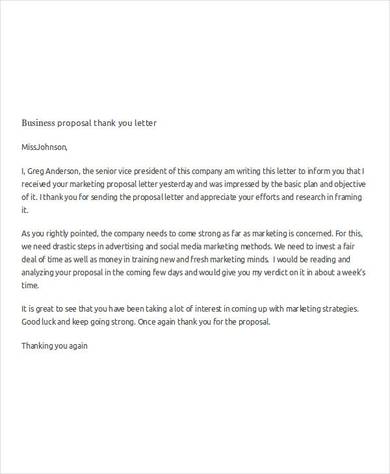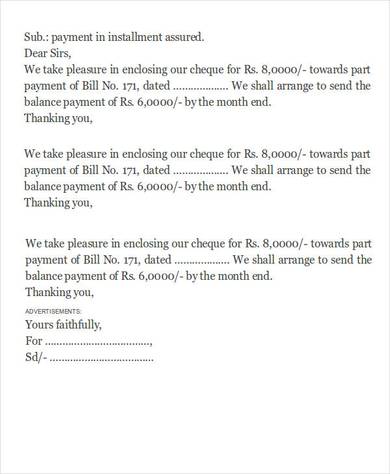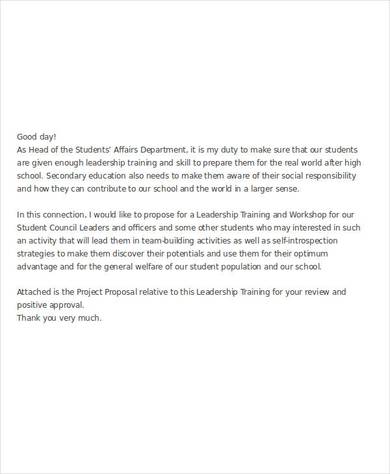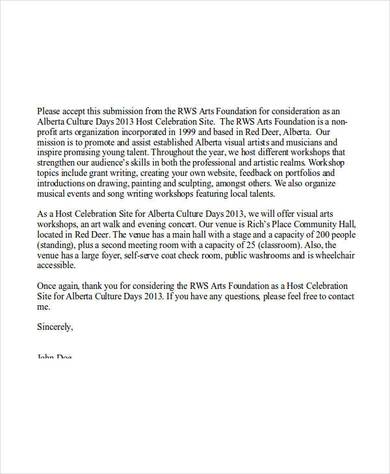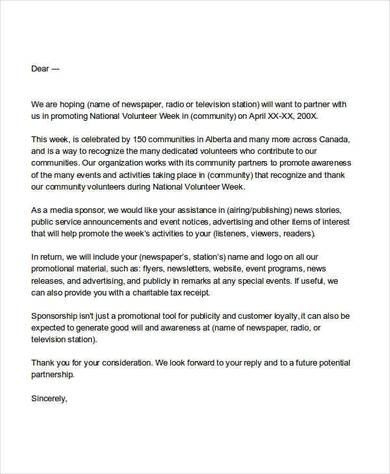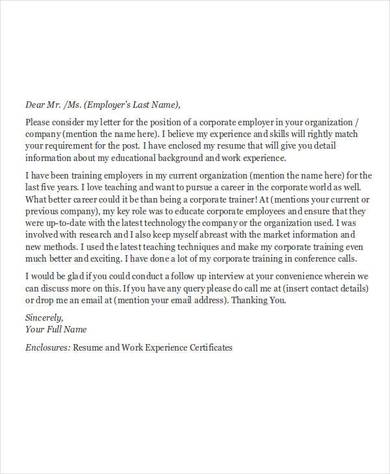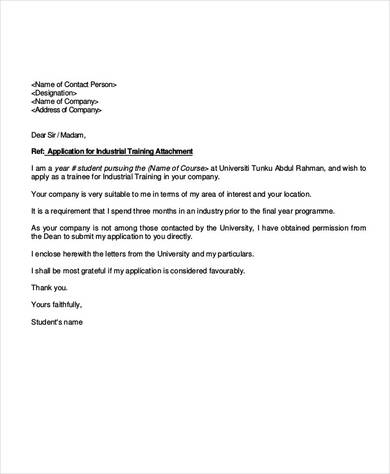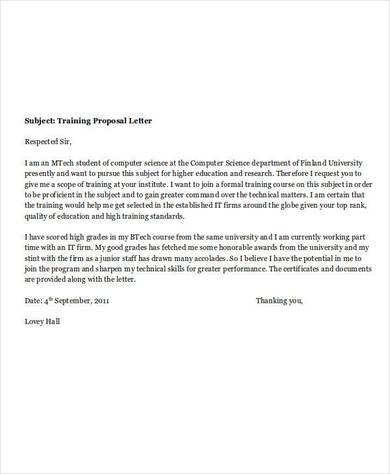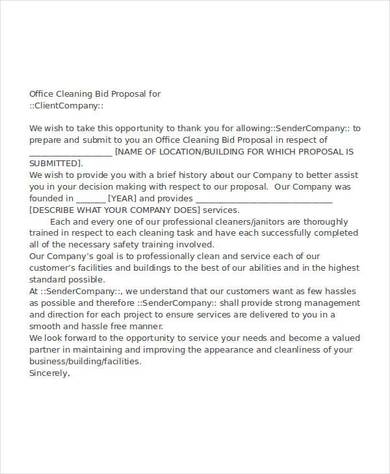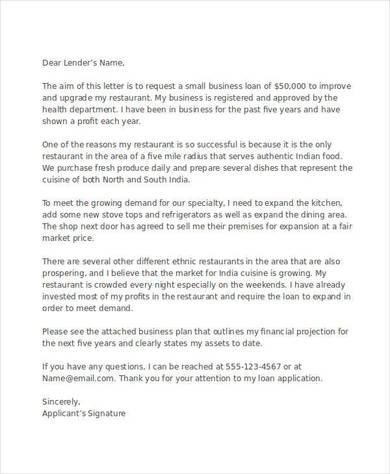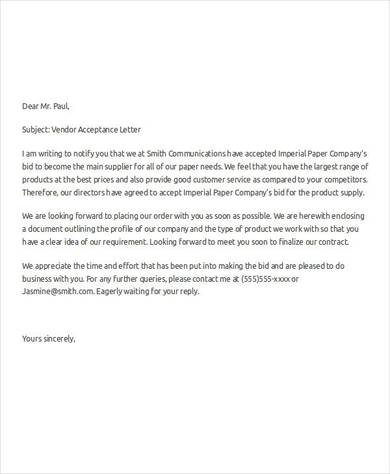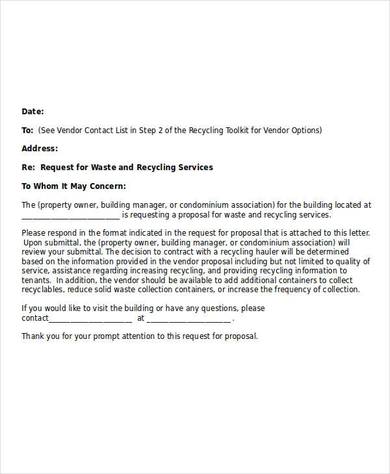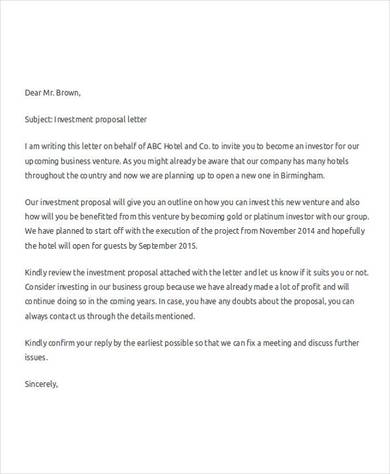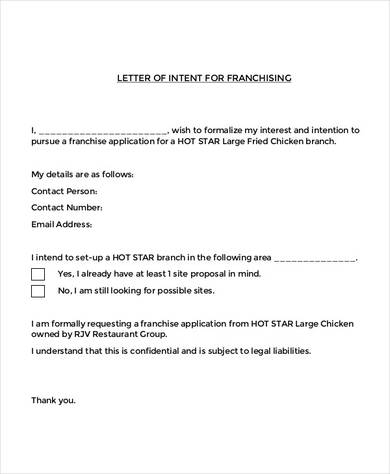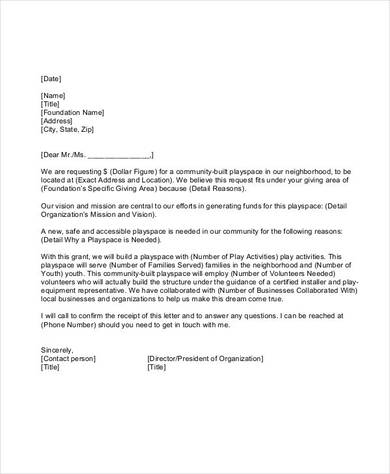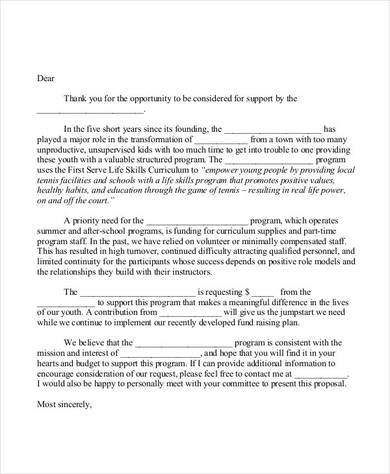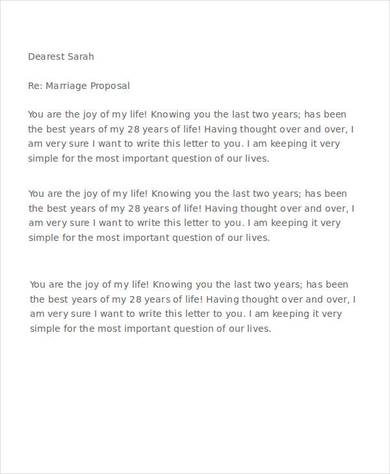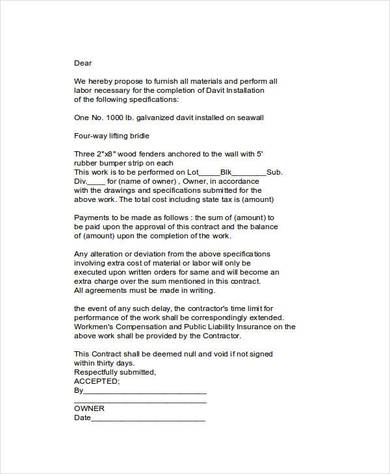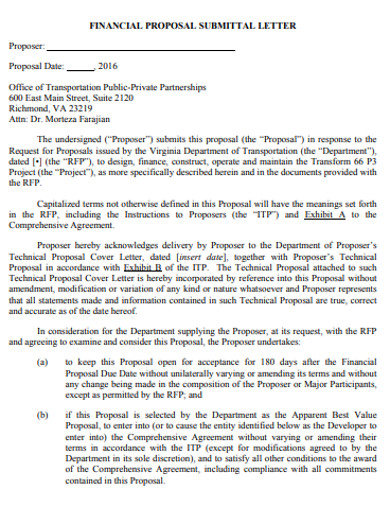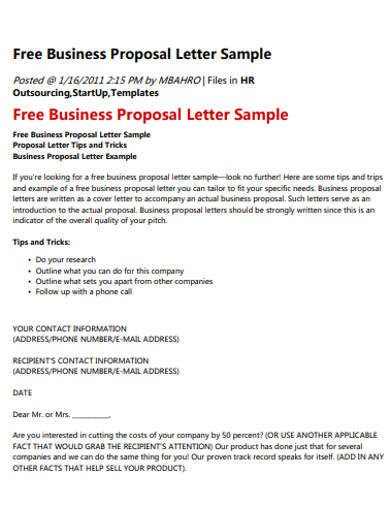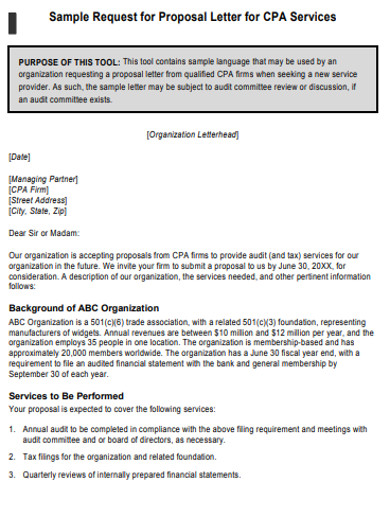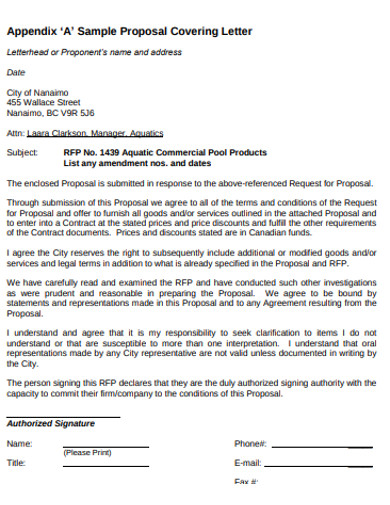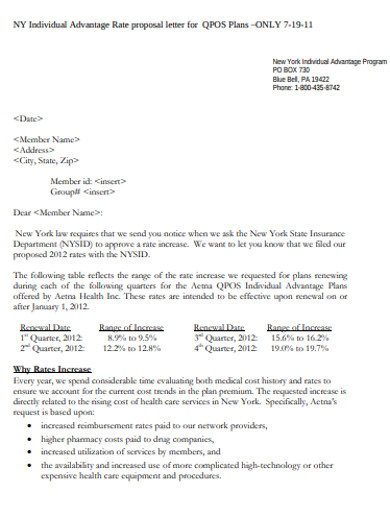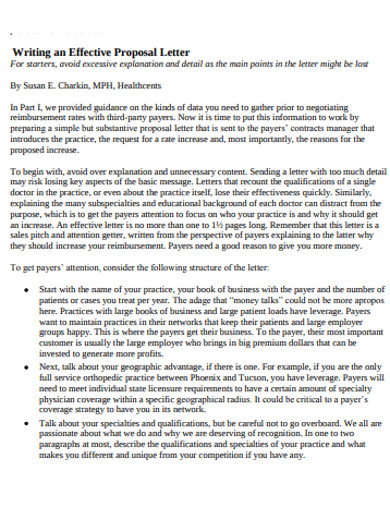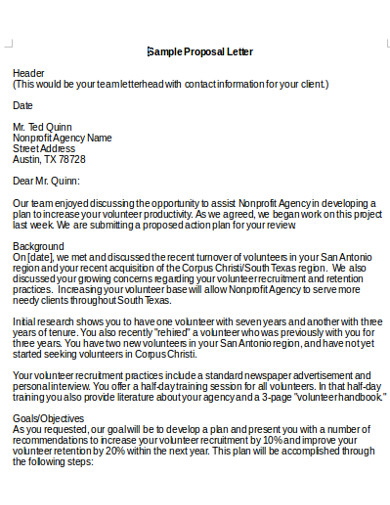66+ Proposal Letter Examples to Download
Good communication is critical in carrying out successful transactions in the world of business. How a given message is delivered can greatly affect the way you’re perceived. Whether you’re writing a formal proposal letter or just a simple business letter, proper formatting and delivery ensure that your audience understands the message you are trying to convey, and it increases their likelihood of reading them favorably.
As a formal business document, the proposal letter must contain useful content that is relevant to the corporate transaction at hand. While there are no firm rules as to how the letter must be written, there are a few standard guidelines that must be noted to make sure the letter carries out its purpose effectively. To help you write a professional proposal letter, refer to the templates and samples provided in this post.
Long Letter Enclosing Proposal Template
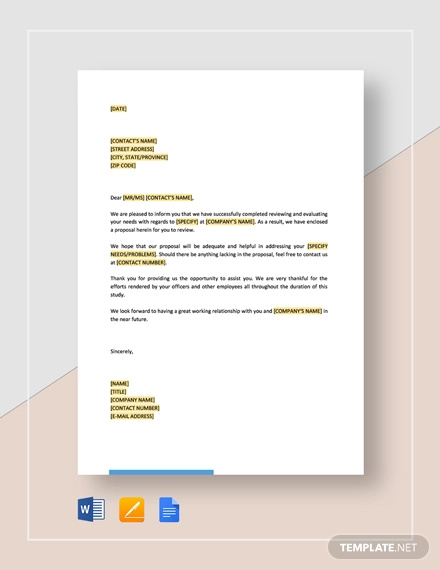
Short Letter Enclosing Proposal Template
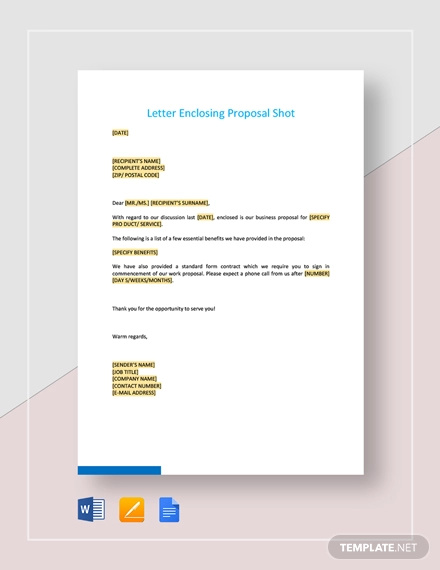
Minimalist Short Letter Enclosing Proposal Template
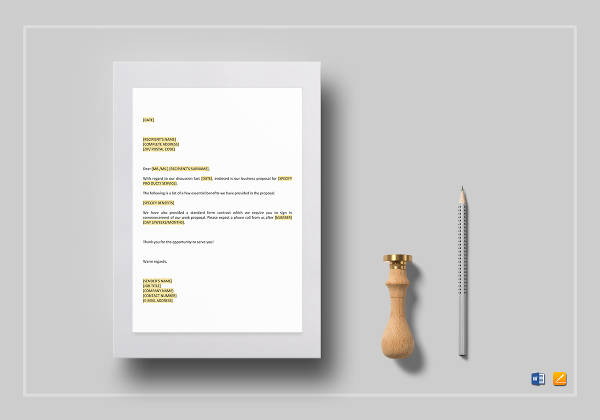
Basic Proposal Letter Template
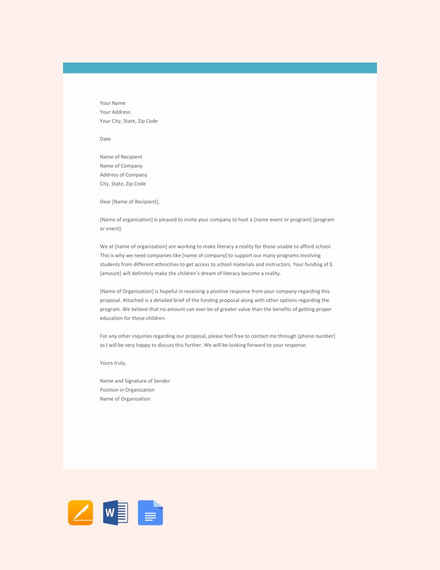
Simple Proposal Letter Template
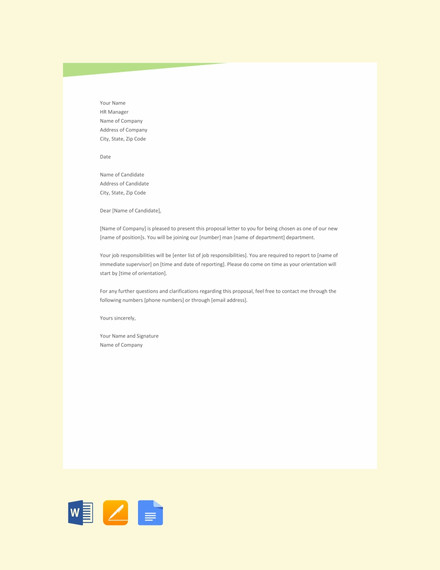
Formal Proposal Letter Template

Product Business Proposal Letter Template

What Is a Letter of Proposal?
A proposal letter is a professional letter that typically states how an organization, institution, company, or any given entity could support a corporate venture of yours. Say, for example, a job applicant vying for a position in a company submits a job proposal to a potential employer.
In the proposal, the applicant tries to convince an employer he is the perfect candidate for the position by sharing a detailed description of his skills and capabilities. By letting a prospect know how you could be an asset to the company, you can easily persuade them to allow you to become a significant part of the enterprise. You may also see business proposal letter examples.
A letter for proposal may also be written for various reasons—in particular, the letter may be used to request a grant, a business loan, or a publication.
Event Proposal Letter
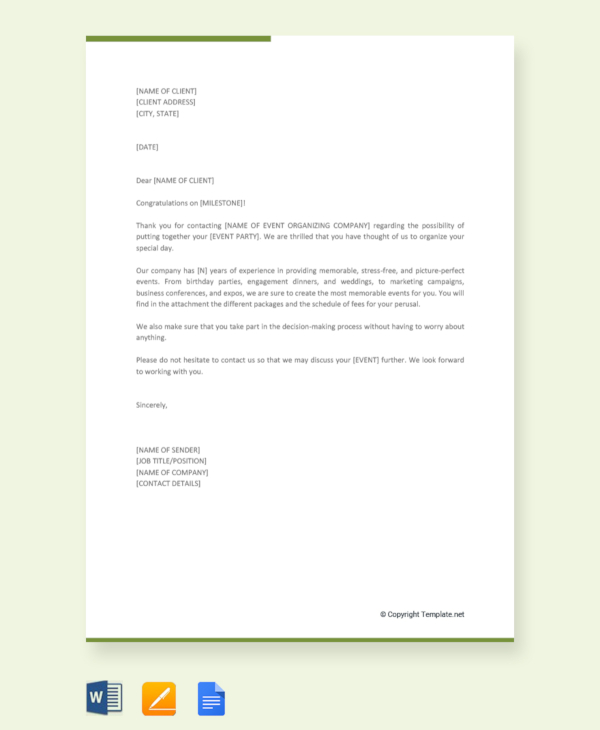
Lease Proposal Letter Template
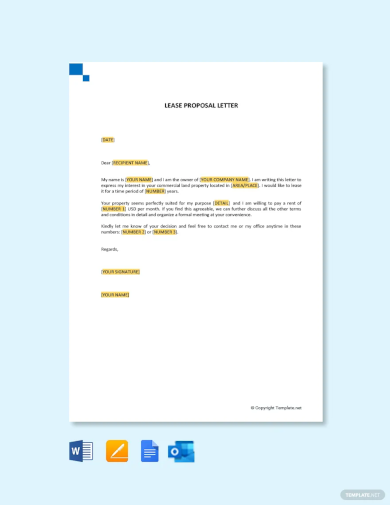
Partnership Proposal Letter Template
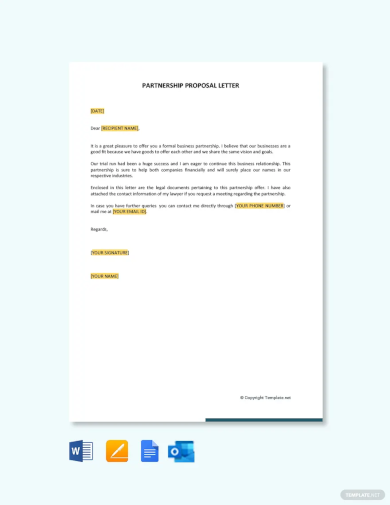
Commercial Lease Proposal Letter Template
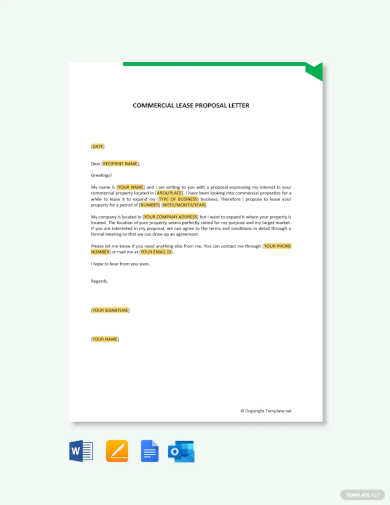
Proposal Letter for Business Template
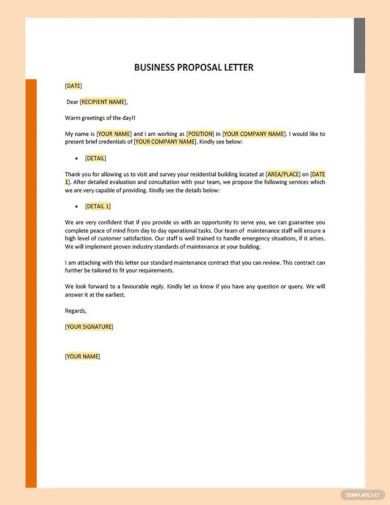
Proposal Letter to Supply Products Template
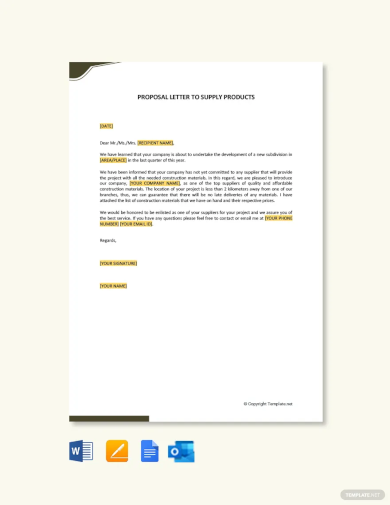
Lease Proposal Letter of Intent Template
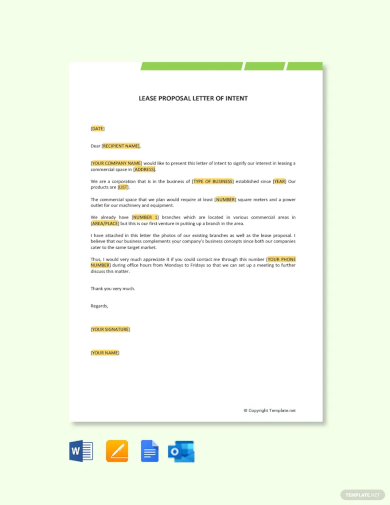
Formal Business Proposal Letter Template
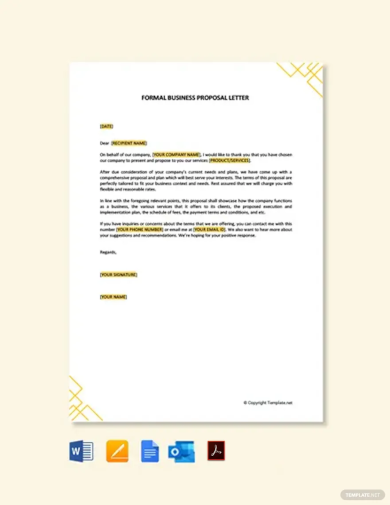
Strategic Partnership Proposal Letter Template
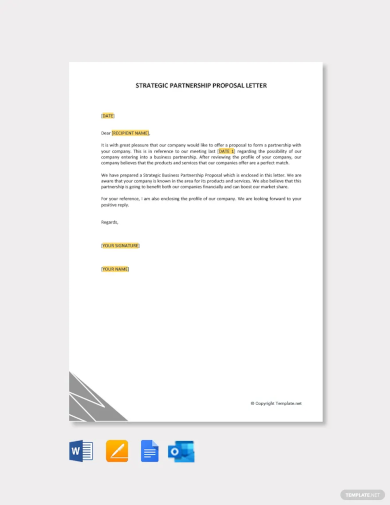
Product Sales Proposal Letter Template
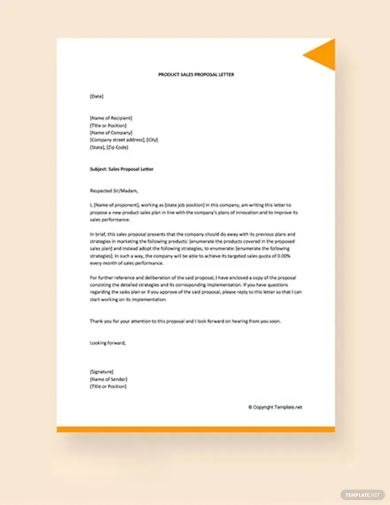
Formal Proposal Letter for Partnership Template
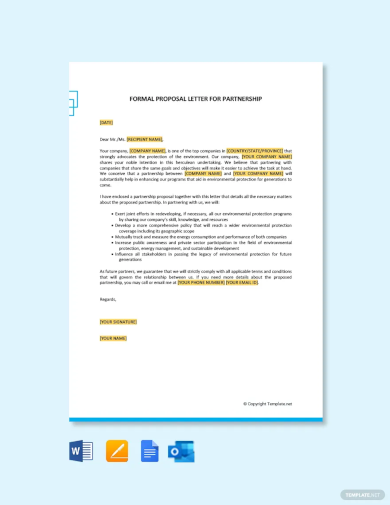
Business Proposal Letter for Partnership Template

Catering Proposal Letter Template
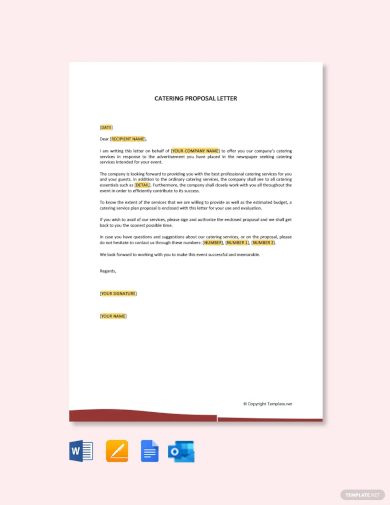
Business Partnership Proposal Letter Template
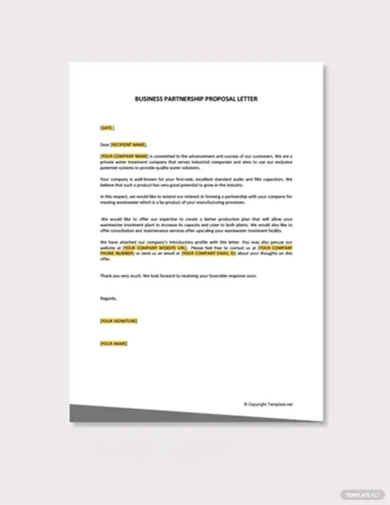
Business Proposal Letter for Service Template

Event Partnership Proposal Letter Template
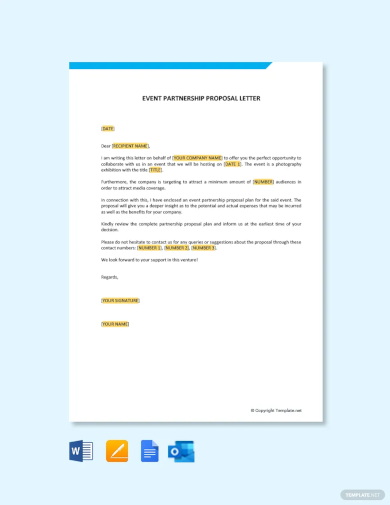
Proposal Letter to Sell Products Template
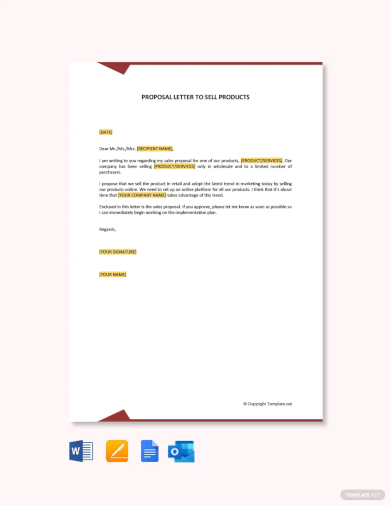
Business Proposal Letters
Business Sponsorship Proposal
Business Proposal Letter to Client
Business Sales Letter
Love Proposal Letter Examples
Love Letter for Boy
How to Make Your Business Proposal Letter Persuasive
Most people put a lot of effort into creating an actual business proposal while disregarding the importance of a business proposal cover letter. Unfortunately, those who dismiss its importance are essentially missing out on a great opportunity to build a deeper connection with the prospect they are communicating with.
Given the significance of a business proposal in making a sale, a cover letter must be crafted in such a way that expresses your willingness to offer a solution (a product or service) to the buyer’s problems. At the very minimum, you must create a sense of curiosity that will compel its intended audience. This will prompt a reader to continue reading your executive summary, along with your full business proposal.
Through this, you’d have the opportunity to convince a prospective client why you possess the best solution to whatever issue they might be facing.
To guide you in writing a persuasive proposal letter, refer to the following steps:
1. Maintain formality.
Before you begin making your pitch, you need to make sure your letter is structured professionally. This will help you establish a level of formality and authority to show prospects that you’re serious about you do. Be sure to follow the standard business format when writing a formal letter to ensure that your proposal letter contains relevant details that clients might find useful.
2. State the problem.
Once you have decided on the format, you can then start working on the body of your letter.
The content of the proposal letter must tackle the first thing that brought everything else together: the problem. For a solicited business proposal, you can begin by expressing the current issue at hand. This is usually indicated in the first paragraph of your letter and must be kept brief (a single sentence would do). An unsolicited business proposal, on the other hand, needs to be a bit more explosive to make a person sit up and grasp what you have to say.
You can start with a question or a monetary implication of a particular problem to evoke emotions. This way, you can shed light on issues that might have never been taken into consideration before.
3. Provide a solution.
Tell the reader what you could do to help them. Bring everything you have in store for them to the table. Start with a sentence or two expressing your conviction on the problem, followed by a list of objectives that you intend to achieve through your offered product or service. Be sure to provide a bullet list of smart goals that are convincing enough to make the reader see things from your perspective.
4. Offer the proposed benefits.
Remember, you’re writing a letter for your business proposal, so you’re merely trying to persuade a person to read the full content of your proposal through a written letter. Hence, you must answer all the possible questions the recipient might have regarding why the time spent reading your proposal would be worth it. Rather than emphasizing the key features of your product or service, you can state the benefits that the recipient will likely receive if they purchase your solution.
5. Create a call to action.
To end your proposal letter, tell the reader what he or she could do next. This may be in the form of an encouragement to prompt a recipient to continue reading your proposal or to get in touch with you to bring the conversation even further. If necessary, you can also provide contact information to make it easier for prospects to reach you. You may also see email cover letter examples.
Once you’re finished writing the letter, be sure to review and edit the letter until you’re completely satisfied. Read and reread the letter to see if any mistakes might have been overlooked or details you might have forgotten to include.
Advertising Proposal Letter Samples
Magazine Advertising Proposal
Advertising Campaign Proposal
Bid Proposal Letter Sample
Bid Proposal Cover Letter
Construction Bid Proposal
Construction Proposal Letter Sample
Construction Proposal Letter
Construction Project Proposal Letter
Construction Services Proposal
How to Write a Cover Letter for Your Grant Proposal
Creating a grant proposal can be a hectic task for any organization. Grant proposal might not be the winning factor to resolving a funding emergency, but it does help a charity gain enough support from various sponsors. Considering the weight of what is asked, it’s important to pay close attention to every aspect of your proposal, including its cover letter.
The cover letter is almost like the front porch of your proposal. Since first impressions play a huge role in closing a business deal, you’d want to leave an impact with the person who can fund your grant.
1. Basic Attributes of a Good Cover Letter
When creating a cover letter for your grant proposal, remember to keep it short and to the point. But instead of repeating what has been stated on the proposal, it should tell the reader how well you understand the nature of their business and how your grant can meet their requirements. You may also see simple resignation letter examples.
Building a personal connection with your prospects will allow them to see just how much of an asset you could be to their day-to-day operations. If you make it seem as if you care more about the monetary benefits than the actual welfare of the company, your grant proposal is bound to be ignored and thrown out right after the cover letter has been read. You may also like notice letter examples.
Keep in mind that the cover letter must only be constructed once you have finished with the entire proposal. This way, you’d know exactly what to include in the letter based on what has been expounded in your proposal.
2. Tips on Formatting Your Cover Letter
Following a proper format for your cover letter is extremely important to project professionalism. Observe the basic principles below, and you’d be good to go:
- Use the official business letterhead. For formality’s sake, use the corporate letterhead of the business you are representing. The date on the cover letter must be the same date indicated on the grant application as well. By doing so, consistency is met throughout the entire proposal package.
- Include an updated inside address. The inside address (which goes at the top of the letter) must contain the contact person’s name and title, followed by the funding source’s name and complete address. Double-check this information to see if it’s up to date. Such details are bound to change without prior notice, so make sure you have the current name and address listed on the letter. You may also see application letter examples & samples.
- Begin with a salutation. As standard letter-writing etiquette, always begin the letter with a greeting or salutation. You can use “Dear” plus the person’s title (Mr., Ms., Mrs., etc.), followed by their surname. It’s critical to address the letter to a particular person to ensure that it falls to the right hands. If you aren’t sure who to address it to, then you can contact the foundation or corporate office to clear things out. Though this information might not be as impactful as the rest of the content, it matters nonetheless. You may also like complaint letter examples & samples.
- End with a summary. After expressing your purpose for writing in the first two to three paragraphs, end the letter with a summarizing paragraph. This is your last chance to convince a reader into considering your grant proposal, so you might want to add in a few points that might interest them. For instance, you can tell them what this funding partnership can mean to your target audience, or you can offer a firsthand experience of the issue at hand through a site visitation. You may also check out thank-you letter examples.
- Never forget the signatures. Below the closing part of your letter, remember to have it signed by the executive director or the board president in charge. The signature must be located above the signer’s full name and job title. In most cases, you can formally end the letter by including the word ENCLOSURE in all caps.
When creating your grant proposal letter, remember to highlight the purpose of your program, along with the impact it leaves on the desired audience.
Many corporate entities care about touching the lives of the general public, as it usually gives them an enchanting brand image that customers are sure to remember. But don’t just make this a business deal that companies must give in to, as you must also make them care about your mission as everyday human beings to keep them fully involved in the process once the proposal has been approved. You may also see appointment letter format examples.
Project Proposal Letter
Senior Project Proposal Letter
Job Proposal Letter Sample
New Job Proposal
Accepting Job Letter
Product Proposal Letter Example
Product Sales Proposal
Internship Proposal Letter
Summer Internship Proposal
How to Start a Business Proposal Letter in 5 Simple Steps
A business proposal letter is a document used to introduce an idea to entrepreneurial entities such as investors, higher executives, potential business partners, etc. and persuade them to support the said concept. However, before you could convince them, there is still something you need to accomplish— catch their attention.
Just like writing an essay or report, it is the job of an introduction to allure the audience so they would read the entire content of your composition. In other words, it is highly essential to observe the quality of this segment. To compose an applaudable intro, you may consider following through these steps:
1. Begin with a splendid greeting.
In your letter, you are not just relaying a message but also creating a pleasant impression. Likewise, leave your readers the best impression by starting with a professional business greeting. Though it is already a common sense in ethics, this form of politeness is yet disregarded by some writers. Moreover, some proponents are still poor in constructing their salutations. For you to be guided, here are some samples of professional letter salutations:
- Dear + full name of the receiver; e.g. Dear Juvely Mills,
- Dear + Mr., Ms., or Mrs. + last name of the receiver; e.g. Dear Ms. Mills,
- Dear + Mr., Ms., or Mrs. + full name of the receiver; e.g. Dear Ms. Juvely Mills,
- Dear Sir, Madam or Ma’am,
- Dear Human Resources Manager
- To whom it may concern:
Furthermore, sync the tone of your greetings to the formality of your letter.
2. Place the groundwork.
Upon opening the envelope, the reader always wants to know the purpose of the letter as soon as possible. Hence, give that to your audience. In your proposal letter’s opening sentences, state the context in a straightforward but creative way. Craft an introductory statement that would be ultimately suitable for your prospective recipient. For instance, if you already have a past interaction with your audience, you can mention the most recent one as a transition. If not then asking an interesting and captivating question is a good choice. Also, see to it that the question is also relevant to your proposed idea.
3. Distinguish the problem.
In your introductory part, state the dilemma that you want to address using your proposed idea. In doing this, depict the scenarios or situations that would support your point that these problems are indeed serious and need to be addressed. This is a critical aspect of your introduction since it tackles the idea that your suggested product or service is something that would be purchased by the target consumers.
Within this section, you can conduct a survey or experiment that would support your proposal. This would make your argument much stronger as well as more persuasive. Statistics and facts are great game-changers as well.
4. Mention the benefits of your proposal.
Now that you already have mentioned the issues you want to resolve, back it up with a statement that shows how will your proposed product or service be helpful in the scenario. Nonetheless, do not uncover the deepest details regarding your proposed solution yet. Instead, give them the sneak peek here. Hence, simply provide them with a comprehensible yet intriguing message.
5. Ask questions to be responded to in the proposal.
Ending the beginning of your introduction could be as challenging as opening it because it acts at the transition to your next paragraph. However, do not feel troubled because we have an easy way to do that. For you to obtain a closing part in your introduction that would persuade the readers to continue reading is to ask some spellbinding questions that you intend to answer in the later part of your proposal. Remember, you don’t aim to inform your audience in this final step, intend to give your audience some hints instead. Furthermore, you can also open your expertise in the field you are proposing in which you can expound on your proposal.
Proposal Rejection Letter Sample
Bid Proposal Rejection
Marriage Rejection Letter
Proposal Cover Letter
Business Proposal Cover Letter
Sponsorship Proposal Cover Letter
Salary Proposal Letter Example
Salary Review Proposal
Salary Proposal Acceptance Letter
Promotion Proposal Letter
Job Promotion Proposal Letter
Proposal Thank You Letter
Business Proposal Thank You Letter
How to Write a Business Proposal for Clients
When creating a business proposal, you need to develop a plan that is worthy of your client’s time and attention. It should indicate how your product or service may solve your client’s most antagonizing problems through a simple solution that only you could offer. To do so, you must understand the problems or issues that your clients currently face, along with why they should consider doing business with you in the first place. Focusing on the finer points of the business document can greatly affect the way your message is perceived by recipients.
Accordingly, three things must be addressed when creating a corporate proposal, these are as follows:
1. Your Client’s Needs
Many proposal writers focus too much on their own business that they often fail to understand their client as a whole. This includes the nature of what they do, the industry they are in, and the challenges that they face. Knowing this, try pondering on these questions to construct the first section of your proposal:
- What are the challenges faced by this industry?
- What is the current challenge faced by the organization or company?
Once you have found your answers, this will then open a series of related questions that could be useful in writing the proposal. You can also gather answers from the client to generate better results. You may also see recommendation letter examples & samples.
2. Your Solution
When conveying your proposed solution to one’s problems, you must portray your understanding of such needs. This includes relevant industry research and benchmarks that may support your analysis. Next, you’d also need to provide information regarding the process that must be executed to solve a problem. You may also like acknowledgment letter examples & samples.
Make sure that each step in the process is of great value, otherwise, you may be questioned as to why it is necessary. The potential results and its impact on the client’s needs should also be stated in this section.
3. The Administration
Finally, you’ll need to address the administrative aspects of your business proposal as well. This includes a preliminary timeline of project tasks and responsibilities, the milestone to be attained, the budget of your project plan, as well as the terms and conditions that must be met.
Furthermore, you’d also want to avoid using long, complex paragraphs and jargon that might be difficult to comprehend. Most experts strongly suggest that you limit your letter to one page consisting of three or four paragraphs. Since the reader has an entire proposal to go through, you wouldn’t want to waste their precious time with your official letter. Short sentences and simple wording would be your best option to ensure clear communication.
Payment Proposal Letter Example
Installment Payment Letter
Letter of Event Proposal
Letter for School Event Proposal
Proposal for Event Venue
Event Partnership Proposal Letter
Training Proposal Letter Example
Corporate Training Letter
Industrial Training Proposal
Computer Training Proposal Letter
What Business Should You Approach for a Sponsorship Proposal?
Failed business ventures are often the product of poor decisions. If your company chooses to do business with an organization that doesn’t possess similar objectives as you do, there would be many hurdles and uncertainties that would prevent you from achieving success.
Going from a sponsorship seeker to an official marketing partner is far from simple. Apart from creating an impressive sponsorship proposal, you must first look for a business that would best suit your end goal. This would depend on the specific market being catered, what you can offer the sponsor, and how you may benefit from them. Looking for potential sponsors is a grueling task to undertake, considering the amount of time and effort that one puts into the search, along with the number of rejections you’re likely to face.
Remember, this is a vital step that you must commit to. So to find the perfect sponsor, take note of the steps below:
1. Create a wishlist.
When creating your list, consider the needs of your target audience, the social connections you have to a given sponsor, the similarities between you and the specified sponsor, as well as their competitors. Jot down company names until you’ve reached a healthy list of about 25 to 30 items. You can always add more to the growing list, as long as you can handle cutting them down later on. You may also see reference letter examples.
2. Conduct research on each sponsor.
Once you have made a list of sponsors, it’s time to do a little background check for each item on the list. The Internet would be the perfect platform to gather a sufficient amount of information. From the company website to their social media pages, you can look for references to a given brand and company by simply inputting certain keywords into the search bar. You may also like employee reference letter samples.
3. Record the data you have collected.
Write down the data you have just gathered on a sheet of paper. Organize this in such a way that it would make it easier for you to draw comparisons between each sponsor.
4. Get a reality check.
No matter how much you want to partner with a company, if they aren’t compatible with your needs and purpose, then they aren’t worth pursuing. Remember to cross them off your list before proceeding to the next step.
5. Contact each sponsor on your list.
Now you’re left with a hotlist of sponsors to reach out to. Though there’s no guarantee that these prospects would be on board with your plans, the least you can do is try. Perhaps you could influence their decision through a cover letter, or discuss your proposed plans over a business meeting. However, don’t waste time on the wrong people. If you can’t break the barrier, move on to the next one on your list and see if you can strike a deal by then.
Additionally, make sure that you’re communicating directly with the person who has the authority to approve your proposal. Otherwise, you might just lose your chance with a company that might’ve been willing to partner with you.
Cleaning Bid Proposal
Marketing Proposal Letter
Restaurant Marketing Letter
Joint Marketing Proposal Letter
Loan Proposal Letter Example
Business Loan Proposal
Vendor Proposal Letter
Vendor Proposal Acceptance Letter
Vendor Proposal Cover Letter
Investment Proposal Letter Sample
Business investment Proposal Letter
Franchise Proposal Letter
Letter of Intent Franchise Proposal
Grant Proposal Letter Example
Budget Proposal Letter
Marriage Proposal Example Letter
Contract Proposal Letter
Sample Proposal Letter
Financial Proposal Submittal Letter
Free Business Proposal Letter
Sample Request for Proposal Letter
Sample Proposal Covering Letter
Individual Advantage Rate proposal letter
Basic Proposal Letter Example
Simple Proposal Letters Example
Proposal Letter in DOC
Proposal Letter Template
What Is the Main Purpose of a Proposal Letter?
We’ve been going on and on about the importance of writing an effective proposal letter in this article, but what purpose do these proposal letters even serve?
A business proposal letter, which can either be solicited or unsolicited, is a type of document used to outline your offered products or services that prospective clients might need. The main goal of creating a proposal letter is to make a formal proposal involving the delivery of goods according to the terms of the transaction. You may also see offer letter examples.
Solicited proposals are typically made at the request of a buyer or a client that might be interested in what the business has to offer. But when it comes to writing a letter of proposal, the seller (business) usually does this for free to make a strong impression with prospects.
Given how the content of the letter is merely a summary—plus a few persuasive facts—of what has been stated on the formal proposal, creating an informative, convincing, and the professional document is extremely important. Keep in mind that the content of the letter represents what the proposal has in store for its prospects. If you fail to write a compelling letter, then this might hinder the person to even consider reading the entire proposal. You may also like incident report letter examples.
The proposal letter is simply a reflection of how much you know about your potential clients, their needs, and what you do to resolve their current problems.
Unfortunately, your business proposal could be among hundreds or thousands of other proposals that a corporate entity receives on an annual basis. Standing out might seem like a chore to do, but this can be accomplished with the help of a good proposal letter. You may also check out job application letter examples.
Creating a cover letter to support your proposal can be beneficial in a lot of ways. At the end of the day, what matters most is your means of delivery to get your point across to potential clients in a way that may be comprehended effectively.
General FAQs
1. What is a Proposal Letter?
A proposal letter is basically a formal business letter that is written to engage prospective clients regarding a new product, business, or a partnership. It outlines how the potential client can be benefitted by using your company’s products or services.
2. What is the Structure of a Proposal Letter?
The structure of a proposal letter is as follows:
- Introduction and background
- Statement of the problem
- Goals and objectives
- Evaluation
- Breakdown of costs
- Contact information.
3. How To Prepare a Proposal Letter?
You can prepare a proposal letter by following these steps:
- Identify the client’s key business needs
- Offer a solution to meet those needs
- Explain your approach towards those needs
- Mention your most important differentiators
- End with a call to action.
4. What is the Difference Between an Executive Summary and a Proposal Letter?
An executive summary is a brief and less detailed version of a proposal. It covers the key points of your offer and how it aligns with the potential client’s strategic priorities. A proposal letter, however, introduces your business and explains that you understand the client’s needs.
5. How Should You Conclude a Proposal Letter?
While concluding a proposal letter, you should summarize the important points of the proposal and emphasize the major concepts. Provide an explanation that connects all the main points and also offer to discuss the idea in greater detail at a later date.


